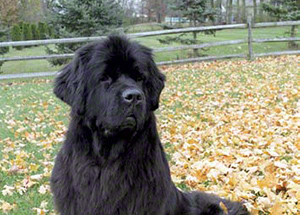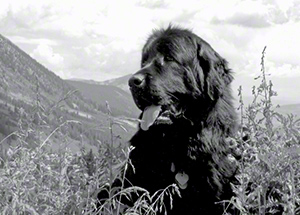The arrival of a new puppy is an exciting event, and the inevitable change in household routine will go much smoother if you’re well-prepared for the arrival of your Newfoundland newcomer. The following items and discussions should help you to get ready – or, if your puppy is already at home, to make sure you’ve covered all the bases. (If you’re not new to dog ownership, some of what’s discussed below will be familiar, but please read through the list anyway, as many of its suggestions are Newf specific. Newfoundlands’ size and breed characteristics mean that what works for a Lab or a boxer won’t necessarily fill the bill now, or at least not when your new member of the family is full-grown.)
CLEANUP
Housetraining rarely goes without a hitch, so be prepared for cleaning up the inevitable. Have plastic poop bags handy (of course you’ll have these anyway; all responsible dog owners always pick up after their dogs), along with paper or fabric towels to absorb urine, as well as some vinegar or a commercial product (those containing enzymes are highly recommended) to clean your floor or rug. One excellent idea for easily picking up inside poop is to cut paper plates in half and scoop along the flat edge.
Machine-washable items
Add a one-pound box of baking soda to your regular detergent and wash as usual, air-drying if possible. If you can still see or smell the soiling, wash again with an enzymatic cleaner — these break down pet-waste odors.
If your pup soils the sheets or blankets on a bed, cover the bed with a vinyl, flannel-backed tablecloth while you retrain them. It's machine washable, inexpensive and unattractive to your pup.
Carpuped areas and upholstery
For "new" stains (those that are still wet):
Soak up as much of the urine as possible: Place a thick layer of paper towels on the wet spot, and cover that with a thick layer of newspaper. If possible, put newspaper under the soiled area as well. Stand on this padding for about a minute, and repeat until the area is barely damp.
If possible, put the fresh, urine-soaked paper towel in your pup’s designated “bathroom area.”
Rinse the "accident zone" thoroughly with clean, cool water, blotting dry.
For stains that have already set:
Consider renting a carpet cleaner from your local hardware or grocery store.
Use a high-quality pet odor neutralizer once the area is clean.
Use carpet stain remover if the area still looks stained after it's completely dry after extracting and neutralizing.
Avoid using steam cleaners to clean urine odors from carpet or upholstery. The heat will permanently set the stain and the odor by bonding the protein into any man-made fibers.
Avoid cleaning chemicals such as ammonia or vinegar. Strong chemical odors may encourage your pup to reinforce the urine scent mark in that area.
Your job will be more difficult if urine has soaked down into the padding underneath your carpet. In some cases, you may need to replace portions of carpet and padding.
Paint and wood damage
If the wood on your furniture, walls, baseboard or floor is discolored, the varnish or paint has reacted to the acid in the urine. You may need to remove and replace the layer of varnish or paint. If you do so, make sure the new product is safe for pups.
Washable enamel paints and some washable wallpapers may respond favorably to enzymatic cleaners such as Rocco & Roxie or Nature’s Miracle.
Finding older messes
In some cases, old messes will have dried invisibly and be hard to locate. To find them:
Use your nose to sniff out soiled areas.
Examine the suspect area closely to catch hard-to-find soiling.
If you have a black light, use it to identify soiled areas, and lightly outline the areas with chalk.

